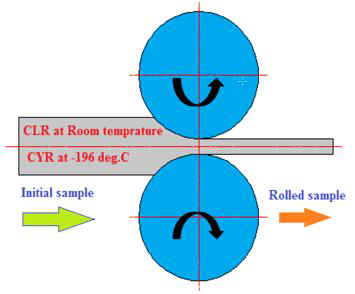Cryorolling of Aluminum and Aluminum Alloys
Abstract
Aluminum alloys have and still do play an important role in the development of the automotive industry through their light-weighting potential and possibilities to replace heavier steels, which are traditionally used.
Cryorolling is a useful low temperature rolling technique, which can improve strength and ductility therefore opening up further opportunities to light weight in even more strength critical applications.
Today, light metals play a key role in automotive industry development due to their lower density compared to steel. Light metals have been increasingly used in several applications such as engine blocks, chassis, rims, etc. However, there are some disadvantages. Light metals such as magnesium and aluminum are generally not as strong as steel and have only found applications in components either where the thickness of the material can be increased to cater for the necessary strength and rigidity or where strength is not an important factor.
The use of aluminum alloys in the automotive industry has increased significantly due to their high strength to weight ratio and corrosion resistance to improve fuel efficiency and reduce CO2 emissions. One of their major drawbacks is lower strength and formability when compared to conventional steels. Replacing steel in the existing safety-critical structural components like bumper systems, door intrusion beams and B pillar in automobiles with aluminum alloys is a major challenge therefore the emphasis on producing aluminum alloy sheets with high strength as well as good formability has gained importance.
To achieve ultrafine grain structured materials several severe plastic deformation (SPD) processes are being widely used. Among these processes, cryogenic rolling or cryorolling is the only process which is suitable for producing thin sheets with ultrafine grain structure in large scale on a continuous basis. Very high reductions in thickness (70-90%) are normally given by rolling the sheets at cryogenic temperatures (nearly at liquid nitrogen temperature) to achieve a high level of grain refinement. During cryorolling process, suppression of dynamic recovery and increase in dislocation density apart from grain refinement lead to significant increase in strength and hardness when compared to conventional room temperature rolling. But, one of the major limitations of cryorolling is substantial drop in ductility and formability. Therefore, these sheets in as-cryorolled condition are not be suitable for sheet metal industry despite their enhanced strength.
Cryorolling is a simple low-temperature rolling process in which the low temperature is maintained by liquid nitrogen. It is a unique mechanical deformation process at cryogenic temperatures by which high strength and ductility combinations can be achieved. In cryorolling process, the material cools, its molecular structure contracts and hence there is entanglement of dislocations near the grain boundaries. The suppression of dynamic recovery in the materials due to rolling at the cryogenic temperature causes density of accumulated dislocations to reach a higher steady state level, which in turn acts as a driving force for the formation of sub-microcrystalline or ultrafine grain structures (UFG) during subsequent annealing treatment.
Figure 1 shows a schematic diagram of conventional cold rolling and cryogenic rolling processes using a two high rolling mill. In conventional cold rolling (CCR), the sheets are rolled at room temperature in number of passes to achieve the final thickness.

Figure 1: A schematic showing conventional rolling and cryogenic rolling
Advantages of Cryo-rolling:
• By cryo-rolling we can achieve a ultra-fine grain structure which improves a strength and ductility compared to cold rolling process
• Handling of the material is easy in cryo-rolling compared to hot rolling precess
• If subsequently we are doing a annealing process after cryo-rolling then we can get a desirable ductility
• Cryo-rolling require a less plastic deformation compared to sever plastic deformation process.From Sever plastic deformation process ,we can also achieve a ultra fine grain structure,but it require a large plastic deformation.
Disadvantages of Cryo-rolling:
• By doing Only cryo-rolling, we can not get a proper ductility. Subsequent annealing process is require, but it is a preferable
• For cryo-rolling process mostly we will use a Al & Cu material as it is a very soft and ductile material and it is not achieve easily a brittle structure at cryogenics temperature.
The significant advantage of cryo-rolling is its ability to produce large scale sample sizes while it also leads to a heavily deformed microstructure with high density of dislocations in nanoscale networks. The plastic deformation required achieving the increase in strength and reduction in grain size is generally lower compared to the SPD processes. The decreased temperature has the large benefit that it leads to a higher steady state of accumulated dislocations compared to normal room temperature rolling. The disadvantage of cryo-rolling is (similar to the other SPD processes) the loss of material ductility due to the high plastic deformation. The strain hardening behaviour is significantly reduced and this leads to poor formability in tension or stretch forming while in biaxial stretching and bending moderate formability has been reported.
Access Precise Properties of Aluminum Alloys Now!
Total Materia Horizon contains property information for 30,000+ alumiums: composition, mechanical, physical and electrical properties, nonlinear properties and much more.

Get a FREE test account at Total Materia Horizon and join a community of over 500,000 users from more than 120 countries.